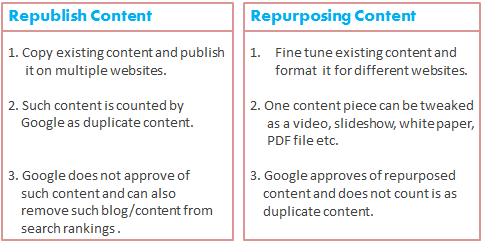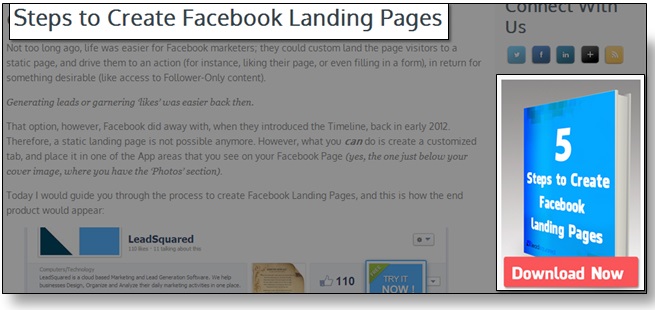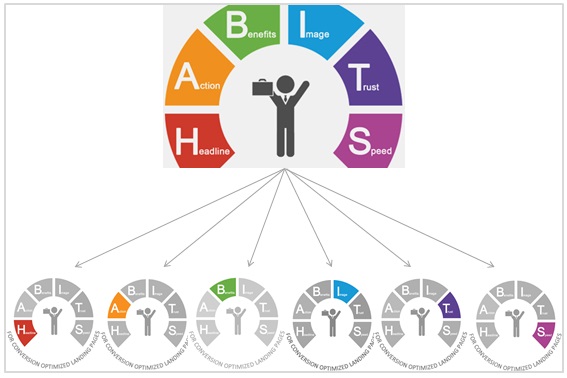“You don’t have to create content, day in, and day out. You just have to work on getting the content you already have… in the hands of more people.”
-Derek Halpern, Marketing Blogger
When it comes to inbound content marketing, generating ‘off the press’ unique and fresh content daily is a major challenge. Then again, if you do not post new and valuable content on your blog, how will you entice and engage your customers? Caught between a rock and a hard place? Content repurposing can address this issue. In this blog post, I will speak about the best practices for Content Repurposing for SEO benefits.
What is Content Repurposing?
Like the term suggests, content repurposing is reforming existing content and using it for a different purpose. Content Repurposing lets you increase the quantity of your content and enhance online visibility of your brand at minimum cost.
Here, you have to understand the difference between ‘Repurposing’ and ‘Republishing’ content.

Why Repurpose Content?
| SEO Benefits | The foremost benefit of repurposing content is to get additional SEO benefits in the form of added search traffic in search engine result pages (SERP). |
| Reach More People through Different Mediums | The content that you repurpose can be formatted into various forms…blogs, EBooks, infographics, well, you get the idea, right? Content Repurposing allows you to leverage one piece of content across various mediums and thereby channel it to more users. Since the content has been tweaked, Google does not consider it as duplicate content and indexes it as new. |
| Save Time | Creating fresh content everyday is time consuming. By content repurposing, since you already have the idea of the topic, you save a lot of time researching, getting quotes, images etc to work with. |
| Cross Platform Promotion | With content repurposing, you can link your videos to your blog or infographic and any other channel. This way you not only cross promote your content through various platforms, you become more discoverable and also increase footfall on your website. |
| Increase the Life of Your Content | Once your content is repurposed in various formats, you will not publish everything in one day right? By increasing the gap between publishing dates, you also increase the life of your content. |
Best Practices for Content Repurposing…
1. Content Repurposing in Different Formats
The trick for proper content repurposing is to see that though the topic of the content is old, it still sounds fresh and new. Since repuropsed content is formatted into various forms, they are not essentially duplicated. Repurposed content improves search engine optimization of your existing content and leverages social sharing. Different formats for content repurposing would include…
1. Blog posts: Create a few blog posts around one topic. People love detailed in-depth posts. To add more usefulness, supplement your post with relevant images. Make sure that all your posts in the same series are interlinked to each other. In this image below, see how I have added links to all my articles under the same series.

2. Videos: You can create videos with either still images or motion videos. Just make sure that they are vocally powerful. Here are a few video tools that you can use.
3. Infographics: Its a lot easier to absorb information when they are in the form of graphics. They can be interpreted easily and are SEO friendly. Here are top 5 infographic tools for non-designers.
4. E-Books: Compile your blog posts into a handy e-book and make it available for free on your website as a source of information for your readers. Like you see in the image below, the blog speaks of ‘Steps to Create Facebook Landing Pages’ and the E-book you see on the right is that of ‘5 Steps to Create Facebook Landing Pages‘. The root of both topics are same, Facebook Landing Pages, but they have been formatted into 2 different forms, one a blog post and the other an E-Book.

5. Webinars: Webinars may be time consuming to prepare, but they open a plethora of opportunities for content repurposing.
6. Podcasts: Interview experts in your field or from your company and develop them into podcasts. Publish them in social networking sites to increase your reach.
7. Presentations: Repurpose your content into presentations or convert a presentation into a blog post and post them on presentation sharing sites like SlideShare. These often rank high thereby bringing you more traffic. Repurposed content on such sites are not considered duplicates because they are different from the original post.
8. Pinterest & YouTube: Anything that can be conveyed via images and videos can be uploaded on image and video sharing sites like Pinterest and YouTube. Just make sure that they are interlinked and linked back to your website.
….and several more…
2. Give ‘Old’ Content a ‘New’ Look
There may be certain articles in your blog archive which may have become obsolete because they were written years or months ago. With content repurposing, you can give those blogs a new look, a new name and add new details to them. This practice will renew them and not make them duplicates, thereby averting the eyes of Google SERPs.
3. Convert Numbered Posts into Individual Articles
I will give you a very simple example for this. At work, we have devised a framework for creating conversion optimized landing pages and we call it the HABITS framework (based on 6 principles on which any landing page functions – headlines, call to action, benefits, image/video, trust and speed). One of my associates had written an article on the same a while back. I formatted the main idea (the post that my associate had written) and converted them into 6 different articles. Viola! Content Repurposed and I have 6 new articles at hand!!
Though the main idea behind the blogs was same, since the content was varied, it served different purposes for different groups of audiences.

This not only saved me time and the trouble to find new topics, but also gave more information to my readers which could not have been covered in one post.
4. Turn a Question into a Blog Post
The perfect example for this is this very same article that you are reading. We had recently held a webinar on “How to Get Started with Website SEO?” and an attendee came up with this question…”What are the Best SEO Practices for Content Repurposing?” My associate had given a one-on-one answer to this question and I turned it into an educational blog post for the larger interest of others who may have missed the webinar and are looking for similar answers. Such content is not considered duplicate content by Google because word of mouth is converted into a written blog post. Comprende’?
At the end of the day, content repurposing is all about re-imagining and re-formatting old content into something new and channel it to different people through different forms. Got doubts? Leave me a comment. :)









